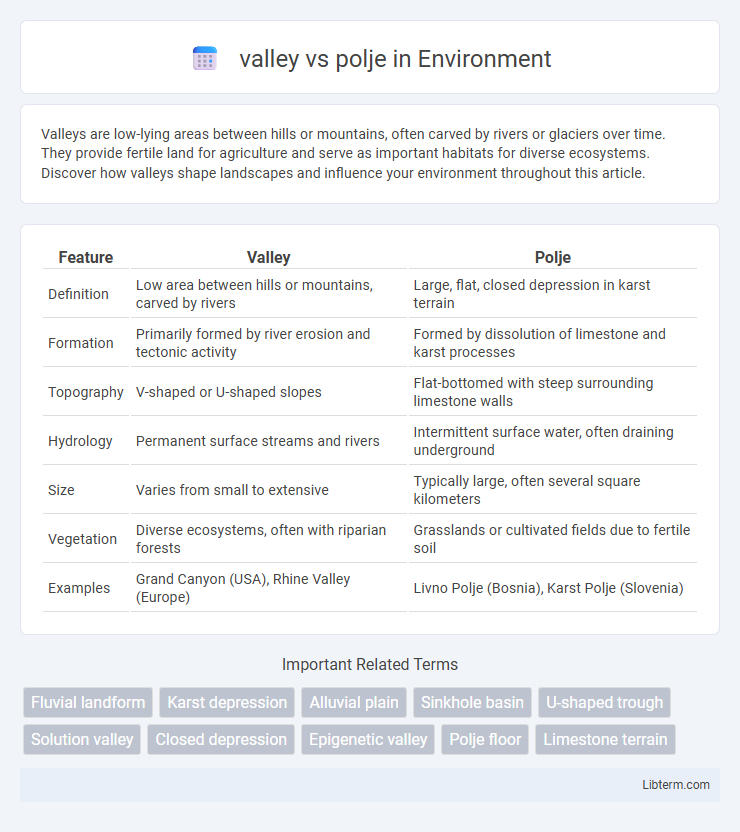Valleys are low-lying areas between hills or mountains, often carved by rivers or glaciers over time. They provide fertile land for agriculture and serve as important habitats for diverse ecosystems. Discover how valleys shape landscapes and influence your environment throughout this article.
Table of Comparison
| Feature | Valley | Polje |
|---|---|---|
| Definition | Low area between hills or mountains, carved by rivers | Large, flat, closed depression in karst terrain |
| Formation | Primarily formed by river erosion and tectonic activity | Formed by dissolution of limestone and karst processes |
| Topography | V-shaped or U-shaped slopes | Flat-bottomed with steep surrounding limestone walls |
| Hydrology | Permanent surface streams and rivers | Intermittent surface water, often draining underground |
| Size | Varies from small to extensive | Typically large, often several square kilometers |
| Vegetation | Diverse ecosystems, often with riparian forests | Grasslands or cultivated fields due to fertile soil |
| Examples | Grand Canyon (USA), Rhine Valley (Europe) | Livno Polje (Bosnia), Karst Polje (Slovenia) |
Definition of Valley and Polje
A valley is a low-lying landform between hills or mountains, typically formed by river erosion or glacial activity, characterized by a V-shaped or U-shaped cross-section. A polje is a large, flat-floored depression found in karst regions, created by the dissolution of soluble rocks like limestone, often featuring seasonal lakes and fertile soil. While valleys serve as drainage channels, poljes act as enclosed basins prone to flooding due to their closed drainage system.
Geological Formation Differences
Valleys are elongated depressions formed by continuous erosion from rivers or glaciers cutting through rock and soil, often characterized by V-shaped or U-shaped profiles depending on the erosive agents involved. Poljes are large, flat-floored depressions found primarily in karst regions, formed by the dissolution of soluble rocks like limestone, creating enclosed basins with steep surrounding walls and often temporary lakes. The key geological difference lies in valleys being primarily shaped by mechanical erosion processes, while poljes result from chemical dissolution and karstification.
Physical Characteristics Comparison
A valley is a long, narrow depression between hills or mountains, typically formed by river erosion, with steep sides and a V-shaped or U-shaped cross-section. A polje is a large, flat-floored karst depression with steep enclosing walls, often found in limestone regions, characterized by intermittent lakes and sinking rivers. Valleys generally have continuous drainage, while poljes experience periodic flooding due to subterranean drainage.
Hydrological Features: Valley vs Polje
A valley is a linear landform shaped by river erosion, characterized by continuous drainage systems with flowing surface water and well-defined river channels. A polje, typical in karst landscapes, is a large, flat-floored depression with intermittent or seasonal water presence, often lacking surface drainage due to subterranean karstic drainage through sinkholes and ponors. Hydrologically, valleys support perennial streams, while poljes exhibit complex underground water flow and temporary flooding influenced by groundwater levels.
Soil and Vegetation Variations
Valleys typically host diverse soil types ranging from alluvial to loamy soils that support rich vegetation, including deciduous forests and grasslands, due to well-drained conditions and nutrient availability. Poljes, characterized by karstic terrain, often have thin, rocky soils with limited organic matter, leading to specialized vegetation adapted to periodic flooding and drought, such as grasses and shrubs. Soil water retention and mineral content significantly influence the distinct plant communities found in valleys versus poljes, reflecting their contrasting hydrological and geological settings.
Typical Locations and Global Distribution
Valleys typically form in mountainous or hilly regions worldwide, with prominent examples found in the Himalayas, the Alps, and the Rockies, where river erosion shapes the landscape. Poljes are large karstic depressions predominantly located in the Dinaric Alps of the Balkans, with notable occurrences in Croatia, Bosnia and Herzegovina, and Montenegro. While valleys appear globally across diverse climates and terrains, poljes are specialized landforms restricted mainly to limestone regions with significant karst processes.
Human Settlements and Land Use
Valleys typically support dense human settlements due to their fertile soil, reliable water sources, and relatively flat terrain suitable for agriculture and infrastructure development. Poljes, large karstic depressions with seasonal flooding, challenge continuous habitation but offer fertile land during dry periods, leading to seasonal agricultural use and periodic settlement patterns. Both landforms influence land use strategies, with valleys favoring permanent farming communities and poljes encouraging adaptive, temporal land management practices.
Ecological Importance of Valleys and Poljes
Valleys serve as critical habitats that support diverse ecosystems by providing water sources and fertile soil conducive to rich vegetation and wildlife proliferation. Poljes, large karstic depressions, offer unique ecological niches with intermittent water bodies that sustain specialized flora and fauna adapted to fluctuating hydrological conditions. Both landforms play vital roles in biodiversity conservation and water regulation, contributing to regional ecological stability and resilience.
Notable Examples Around the World
The Yosemite Valley in California is a prime example of a glacial valley, characterized by its U-shaped cross-section and steep granite cliffs sculpted by ancient glaciers. In contrast, the Livno Polje in Bosnia and Herzegovina represents a classic karst polje, featuring a large, flat-floored depression formed by the dissolution of limestone, often prone to seasonal flooding. Notable poljes also include the Dalmatian Polje system along the Adriatic coast, while famous valleys include the Rift Valley in East Africa, shaped by tectonic activity.
Key Takeaways: Valley vs Polje
Valleys are elongated low areas typically formed by river erosion, featuring a V-shaped or U-shaped cross-section, whereas poljes are large, flat-floored depressions found in karst regions, characterized by limestone bedrock and periodic flooding. Valleys usually support continuous river flow and diverse ecosystems, while poljes often exhibit seasonal water accumulation due to underground drainage systems. Understanding these differences is essential for geological mapping, water resource management, and land use planning in karst and fluvial landscapes.
valley Infographic

 libterm.com
libterm.com